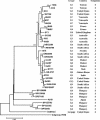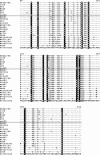Sequencing and phylogenetic analysis of human genotype P[6] rotavirus strains detected in Hungary provides evidence for genetic heterogeneity within the P[6] VP4 gene
- PMID: 15365040
- PMCID: PMC516303
- DOI: 10.1128/JCM.42.9.4338-4343.2004
Sequencing and phylogenetic analysis of human genotype P[6] rotavirus strains detected in Hungary provides evidence for genetic heterogeneity within the P[6] VP4 gene
Abstract
Although rotavirus genotype P[6] is one of the three most common VP4 specificities associated with human infection, the relatively few sequence data available in public databases suggest that the genetic variability within P[6] might be presently unexplored. Thus far, two human P[6] lineages (M37-like and AU19-like) and a single porcine P[6] lineage (Gottfried-like) have been identified by phylogenetic analysis. Serologic studies demonstrated that these three lineages are antigenically distinct from each other, a finding based on which they were classified into three subtypes, P2A[6] (M37-like), P2B[6] (Gottfried-like), and P2C[6] (AU19-like). To study heterogeneity within this genotype, we selected for molecular characterization a total of six P[6] strains detected during an ongoing surveillance in Hungary. The variable region of the VP4 gene was subjected to sequencing and phylogenetic analysis. Our data indicated that these six strains fell into two phylogenetic lineages distinguishable from the human lineages M37-like and AU19-like and from the porcine lineage Gottfried-like. Further studies are needed to understand whether these two novel lineages are genuine human strains or might have originated from animal strains and to evaluate the antigenic relationship of the novel Hungarian P[6] strains to the three established subtypes.
Figures


References
-
- Cooney, M. A., R. J. Gorrel, and E. A. Palombo. 2001. Characterisation and phylogenetic analysis of the VP7 proteins of serotype G6 and G8 human rotaviruses. J. Med. Microbiol. 50:462-467. - PubMed
Publication types
MeSH terms
Substances
Associated data
- Actions
- Actions
- Actions
- Actions
- Actions
- Actions
LinkOut - more resources
Full Text Sources

